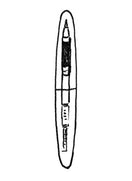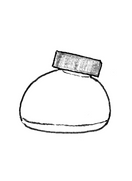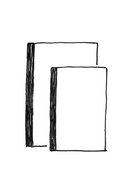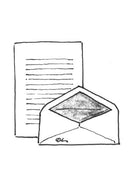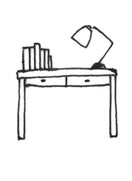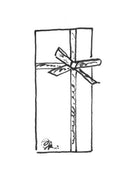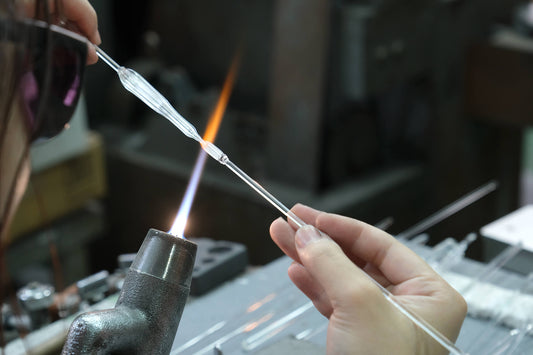Today, we’re introducing woodworker Toshimasa Kawamura, based in Ichinomiya, Aichi Prefecture.
We’ve had the pleasure of working with Kawamura for nearly 15 years, ever since our founder, Takuma Hirose, was drawn to his pieces in a chance encounter. We started stocking them soon after, and his wooden ballpoint pens and dip pen holders have since become beloved staples at Kakimori.
We recently heard from Kawamura about his new ballpoint pen series featuring custom-designed metal parts alongside his signature wooden barrels. For the first time, we visited his workshop to get a closer look at how his pieces are made — from collecting the wood to carving, polishing and finishing each one by hand.
The path to becoming a collector of wood
Stepping into his workshop, we’re met with the sight of countless pieces of wood, stacked from floor to ceiling and filling the space with a warm, earthy aroma. With a shy smile, Kawamura says that he's so used to it now, he can barely smell it anymore.

Kawamura entered the world of woodworking at the age of 34. Until then, for 16 years, he worked as the second-generation owner of his family’s bento shop. One day, his father suddenly told him to decide whether or not to continue the family business, and he chose to follow a different path. At that point he didn’t have a passion for craft, nor was he good with his hands. Still, he figured that as long as he had electricity, he could make it work, so he enrolled in a vocational training program in Yamanaka, Ishikawa Prefecture. And so began a life of collecting wood.

A growing wood collection
Typically, timber is sourced from markets and wood suppliers, but the variety tends to be limited. After deciding to pursue woodworking, he took to the phone book and visited anywhere and everywhere that had some connection to wood. Before he knew it, he had an endless supply of seemingly undesirable wood — from miscellaneous pieces and offcuts to unwanted furniture and old timber collecting dust in warehouses. His initial reason for collecting wood was to source base material for Japanese urushi lacquerwork — usually horse chestnut or zelkova — but over time, his collection outgrew its intended purpose.

Like cooking with leftovers
Kawamura started creating his pieces from his wood collection about 18 years ago. He gradually built a name for himself through entering awards and holding solo exhibitions. When his small wooden containers became popular as tea canisters, he started making a range of tea utensils, followed by tableware and small dishes. From their offcuts, he created ballpoint pens, and finally the remaining wood scraps were turned into toothpick holders or keyrings.
He likens his creative process to ‘cooking with leftovers from the fridge’, finding inspiration in using every last bit of material.

Two techniques
Kawamura uses two woodturning methods in his work: a Japanese-style wood lathe for tableware and canisters, and a Western-style wood lathe for ballpoint pens.


The Western lathe holds the wood securely at both ends, making it ideal for turning long, slender objects like pens. Each piece is carefully finished using sandpaper and wax, sealing its porous surface to prevent warping or cracking.
During our visit, we even had the chance to try our hand at making a ballpoint pen. Using the Western lathe, we attempted to shape a rectangular block of wood into the form of a pen — keeping the blade steady against the rapidly spinning wood proved to be quite a challenge, but with a quick helping hand from Kawamura, the piece was back on track. Watching him move as one with the blade gave us a true glimpse of his craftsmanship.

Wood holds memory and story
These days, Kawamura has a surplus of wood in his workshop and rarely purchases new materials unless something truly unusual or sought-after comes along. His ballpoint pens are each handcrafted from this vast collection of timber, among them jindai (ancient) woods — which have developed a distinctive character from being buried in riverbeds for centuries — and vividly coloured purple and yellow woods that don’t look like wood at first glance.


Despite the wide variety of wood in his collection, he doesn’t price his pens based on the value of the material. ‘I must be the only maker who doesn’t do that,’ he says sheepishly. He believes that every piece of wood in his possession holds its own story and memory — to him, what makes his work meaningful isn’t the name or price of the wood, but honouring its individuality and bringing it to life.

Nowadays, he is assisted by his son, Yūki, the two of them working side by side. Seeing this passing down of skill and knowledge gave us a deeper appreciation for the pens they create.


Each of our wooden ballpoint pens is the result of this unique journey. We have also partnered with our international retailers to make these creations more widely available. Each piece is presented in a custom-made Kakimori box, accompanied by a card introducing the wood it’s made from, and simply titled: Handcrafted ballpoint pen.
We invite you to explore this collection of one-of-a-kind ballpoint pens and find your perfect match.


